2005 VOLKSWAGEN GOLF belt
[x] Cancel search: beltPage 231 of 444

3.1 and Equipm ent
ally.
- Fir st
move the driver's sear and front
passenger's seat as far forward as poss ibl e.
- Pu
ll the re lease handle in the direction
of the arrow= fig. 55 and fold th e backrest
for
ward at the sam e tim e.
WARNING
Improperly positione d safety belts can ca use se rious person al injury in an accident.
Fig . 56 Rear seat: rear seat backrest folded ward
(continued)
Never let passe ngers ride on the rear load
s u rface in th e lu ggage compartment area or sit on the folded down backres ts.
Note
In ord er to prev ent seat damage, the front seat
c u shi ontnust b e fixed in its no rmal horizontal
pos ition before the back res t can b e folded
scat ba ck res t does not press
again st t he fro nt seat.
Page 232 of 444
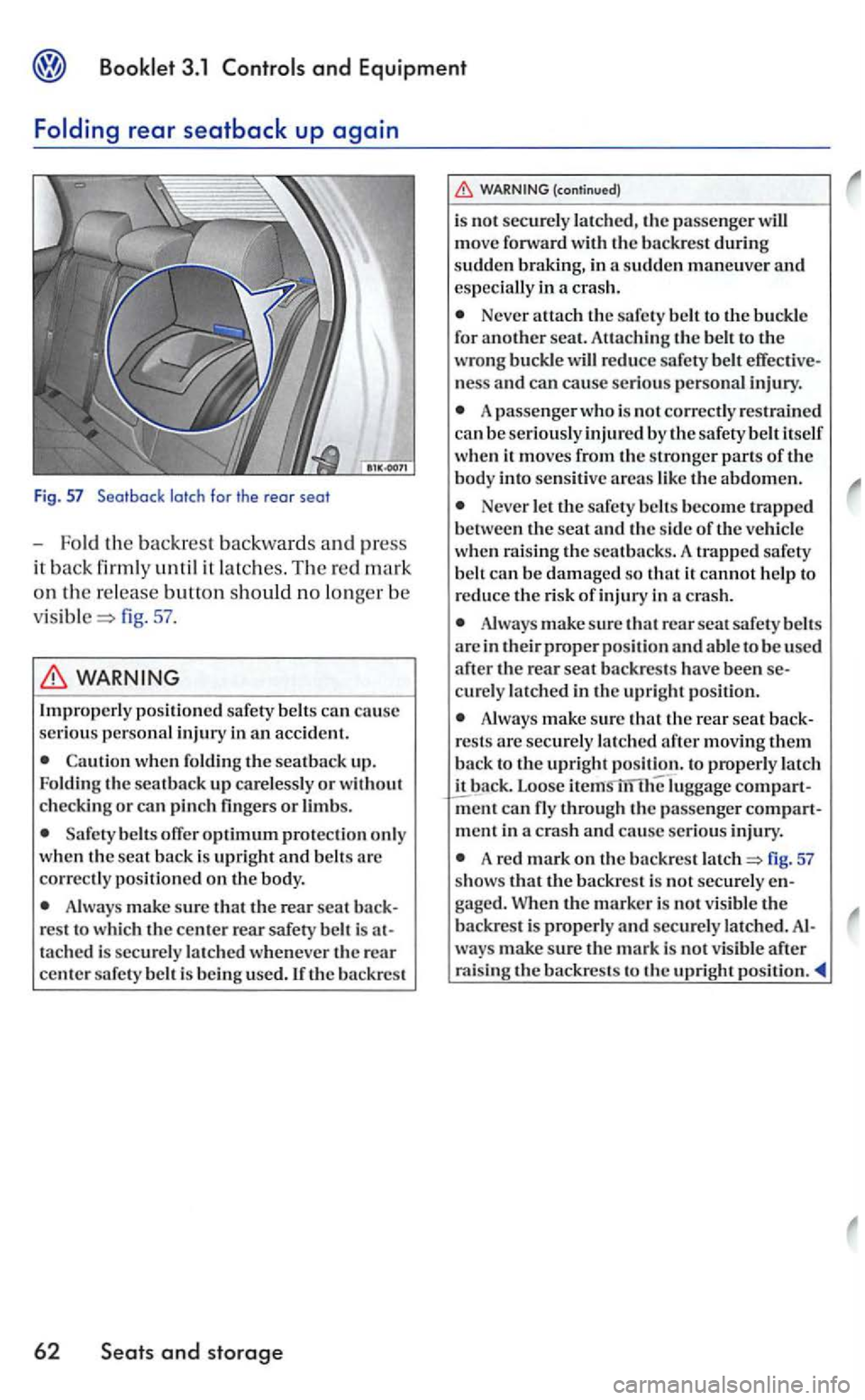
and Equipment
the backrest backwards and press
it back firmly until it latches. The re d mark
o n rhe release button should no lo nge r be
fig. 57 .
when foldin g the seat back up.
Folding the seat back up care lessly or without
c h ecki ng or ca n pin ch fin gers or limbs.
belts offer optimum protection only
w hen the sea t back is upri ght and belts arc
correc tly po sitioned on th e body.
Always make sure that the rear seat res t to whic h th e cente r rear safety belt is t ached is securely la tched whenever the rear center sa fety be lt is use d. If the backrest
62 Seats and storage
(con tinued)
is not secu re ly latched, the passenger move forward with the backrest during
sudde n braking , in a sudden maneuve r and espec ially in a c rash.
Never attach th e safe ty belt to the buckle
for another seat. Attaching the belt to the wro ng buckle ness and can cause serious pe rso nal injury.
A passenger who is not correctly restrain ed
ca n b e se riousl y injured by th e sa fety belt itself
when it move s the strong er parts of the body into sensitiv e areas like the abdomen.
Never le t th e safety belts beco me trapped
between the seat and the side of th e veh icle
when rai s in g the sea t ba cks. A trapped safety
b elt can be damaged so that it cannot help to
r e du ce the risk of injury in a crash.
Always make sure th at rear seat safety belts are in their proper position and able to be used
after the rear seat b ackres ts have been
Always make sure that the rear seat rests are sec urely latched after moving th em
b ack to the upright position. to properly latc h
it bac k. Loose
m ent in a crash and cause se rious injury .
A re d mark on the ba ckrest fig. 57 show s that the ba ckres t is not securely gaged. When the m arker is not visible the backrest is properly and sec urely latch ed. ways m ake sure the mark is not visibl e after raising the backre sts to the upright
Page 256 of 444
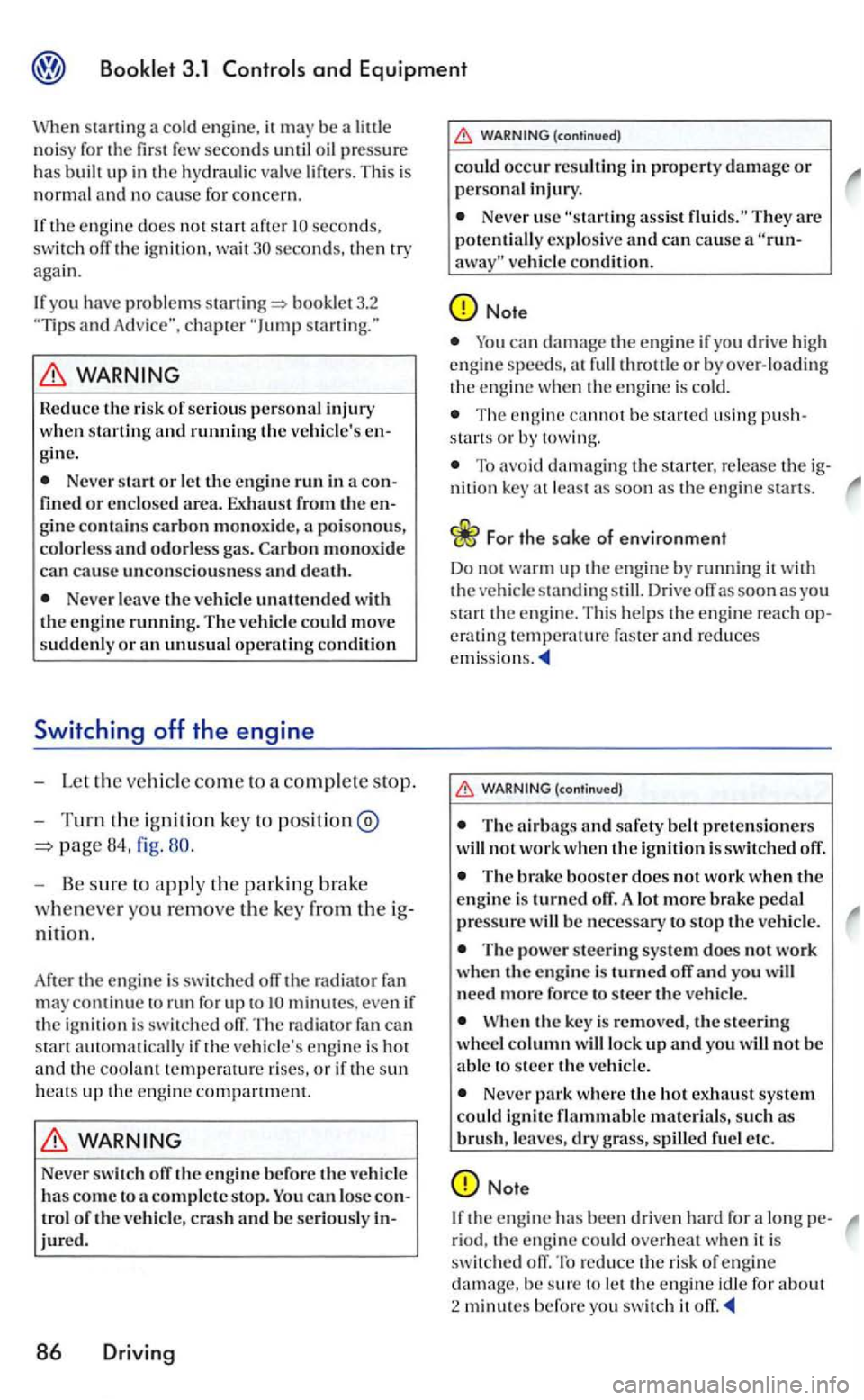
and Equipment
sta rtin g a co ld engin e, it may be a little
n o isy for the first few seconds until oil pressure has built up i n the hydraulic va lve lift ers . T his is normal and n o cause for concern.
I f
the engine does no t sta rt after seconds. switch off the ig niti on, wait seconds, then try
again.
I f yo u
have problem s booklet 3.2 and ch apter
g in e.
Never sta rt or le t the e ng in e run in fin ed or e n closed area. Exhaust from the poi so no us,
co lorless and odorless gas. Carbon can cause unco nsciou sness and death.
Never leave the ve hicl e unatt ended wit h the eng in e runnin g. The vehi cle could move
suddenly or an unus u a l o pe ra tin g condition
Switching off the engine
-Let the vehicle com e to a comple te sto p.
- T
urn th e ig nit ion key to pos iti on @
- Be sure to apply the par k in g brake
w he neve r yo u r
emove the key from the
nition.
Af te r the en gi ne is switched off the rad iator fan
m ay cont inu e to run for up co
Never sw itch off the engine before the vehicle
has com e to a complete stop. can lose tro l of the vehicle , crash and be seriou sly jured.
86 Driving
Neve r u sc "startin g assist fluid s." They are potentially explo sive and can cause a ve hicle cond it ion.
Note
can damage the engin e if you d rive hig h
e ngin e speeds, at full thro ttle or by over- loading
t h e e ngi ne whe n the engine is cold.
T he cann ot be sta rt ed usin g
To avoid the sta rt er, re lease the nition key as soon as the engin e starts.
For the sake of environment
Do not warmup the engine by running it w ith the ve hicle standing s till. Drive off as soon as yo u
s tart the engine. This help s the e ngine reac h
WARN ING (continued )
The airbag s and sa fety belt prc te n si one rs
will not work w hen th e ig n itio n is s wit ch ed off.
The brake booster does not wo rk w hen th e
engi ne is turned off. A lo t more brake pedal press ure will be necessa ry to sto p the vehicle.
T he power steering syste m does not work
whe n the eng in e is turned o ff and you w ill
need m ore force to s teer the vehicl e.
the ke y is remove d , the steerin g
wheel column will lock up and you will not be able to s teer th e ve hicle.
Neve r park whe re th e hot exhaust system could ignite flammable mate ria ls, su ch as brus h , leaves, dry grass, spilled fue l e tc.
Note
If the engine has been dri ven hard for a lo ng riod, th e engine co uld over hea t when it is
switched off. To reduce th e risk of eng ine damage. be sure co Ieee h e e ng in e idl e for about
2 min ute s befo re yo u sw itch it
Page 290 of 444
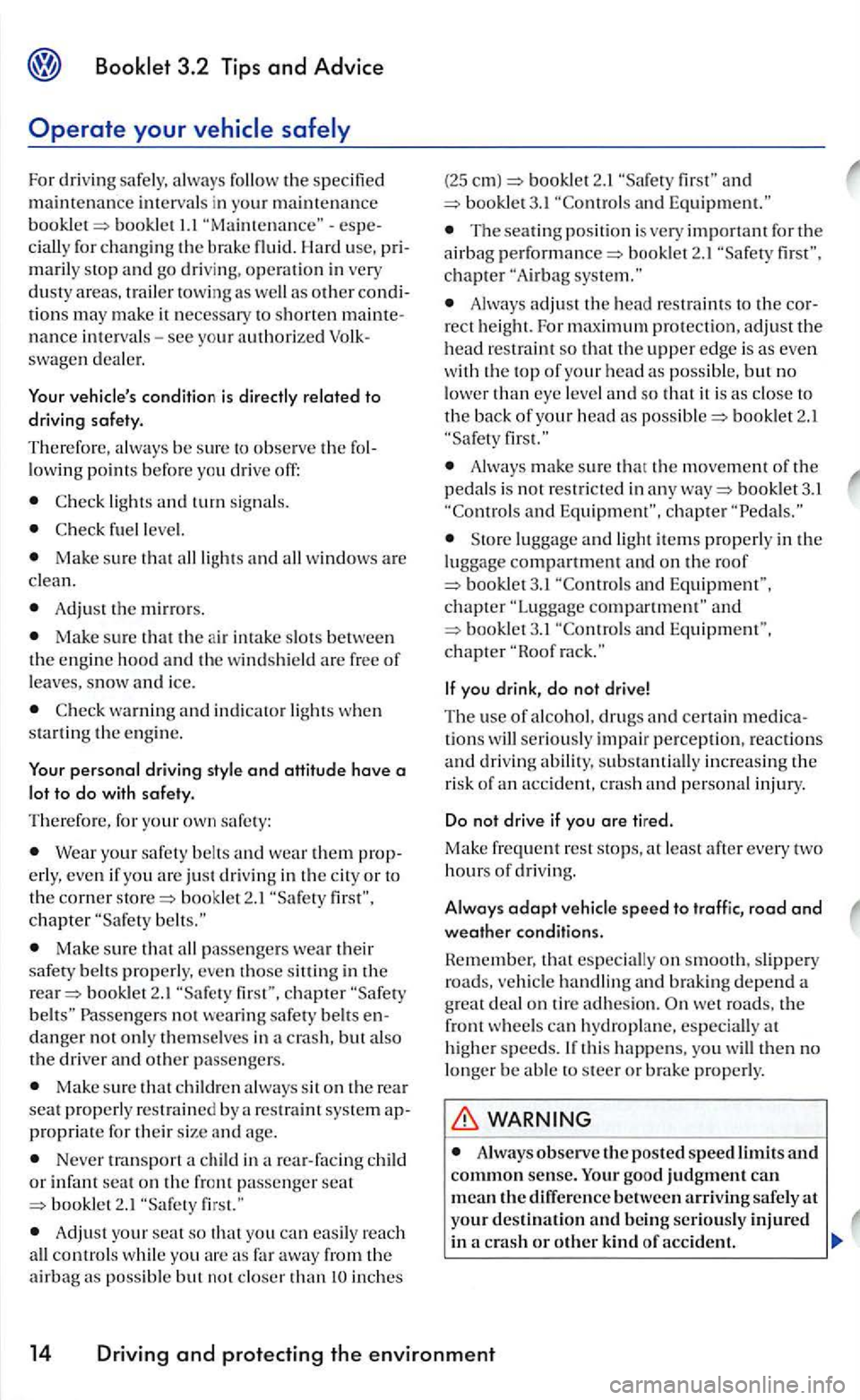
For dri ving safely. always follow the specified
maintenance int erva ls in your mainte na nce booklet 1.1 ciall y for changin g the brake fluid. Hard u se, maril y stop and go driv ing, o p eratio n in very dusty area s. trailer towing as well as other tions may make it necessary to short en nance in te rvals-see your a u th orize d swage n dealer.
Your
l ow ing po int s befo re yo u drive off:
lights and turn signal s.
Make sur e that all ligh ts and all windows are
clea n.
Adjust the mirro rs.
Make sure th at the a ir intake slots between the e ngin e hoo d and the w in d shi eld are free of leaves . s n ow and ice.
wa rnin g and indicato r light s whe n
s ta rti ng the e ng in e.
Your personal driving styl e and attitude have a
lot
to do with safety.
Th eref ore, for yo
ur ow n safety:
Wear your safety belts and wear the m
book let 2.1 chapter
Make sure that all passenge rs their safe ty be lls properly. eve n those sitting in the book le t2.1 chapter Passengers not wear ing safety bells
Make sure that chil dren always sit on the rea r seat properly restrain ed by
Neve r transport chil d in a r ear-faci ng c hild or infant seat on the fron t passe nger seat booklet2.1
Adjust you r seat that yo u can easily reach
all control s while yo u are as far away from the airbag as pos sibl e but not close r than
bookle t2.1 and bookle t3. 1
The seatin g position is ve ry important for th e
a ir bag book let2.1 chapter" Air bag
Always adjust the head rest ra int s to the rect heig ht. For maximum pro tection. adjust the
head restrai nt so the upper e d ge is as eve n
w ith the top of your head a s pos sibl e, but no lower than eye level and so that it is as close th e back of your head booklet 2.1
Always make s ure that th e movem ent of the
p ed als is not re stricted in any booklet 3.1 Equipment",
Sto re lu ggage and light it em s properly in the
lu ggage compartment and on th e roof bookle t3. 1 and Luggag e compartment " and book let3.1 and Equipment", chapte r " Roof
If you drink, do not drive!
The use of alco hol. drugs and certai n tions will seriou sly impa ir percepti on , reac tio ns and dri ving ability, substantially in creasin g the risk of an acc ident, cras h and persona l injury.
Do not driv e if you are tired.
Make frequ ent rest sto ps, least afte r every two hours of dri ving.
Always
adapt vehicle speed to traffic, rood and
weather conditions.
R e
member, that especially on sm oot h. slipp ery
roa ds, ve hicl e ha ndl ing and brak ing depend a
g reat deal o n tire adhes ion. wet roads, the
f ront w heels can h ydropla ne, especi ally at
hi ghe r speeds. th is happen s, yo u will then no
lon ger be abl e to steer or brake properly.
Alwa ys observe the p osted speed limits and common sense. good judg m ent can mean the diff ere nce b e tween arriving safely at your d estination and being seriou sly injured in a cras h or othe r kind of accident.
14 Driving and protecting the environment
Page 306 of 444
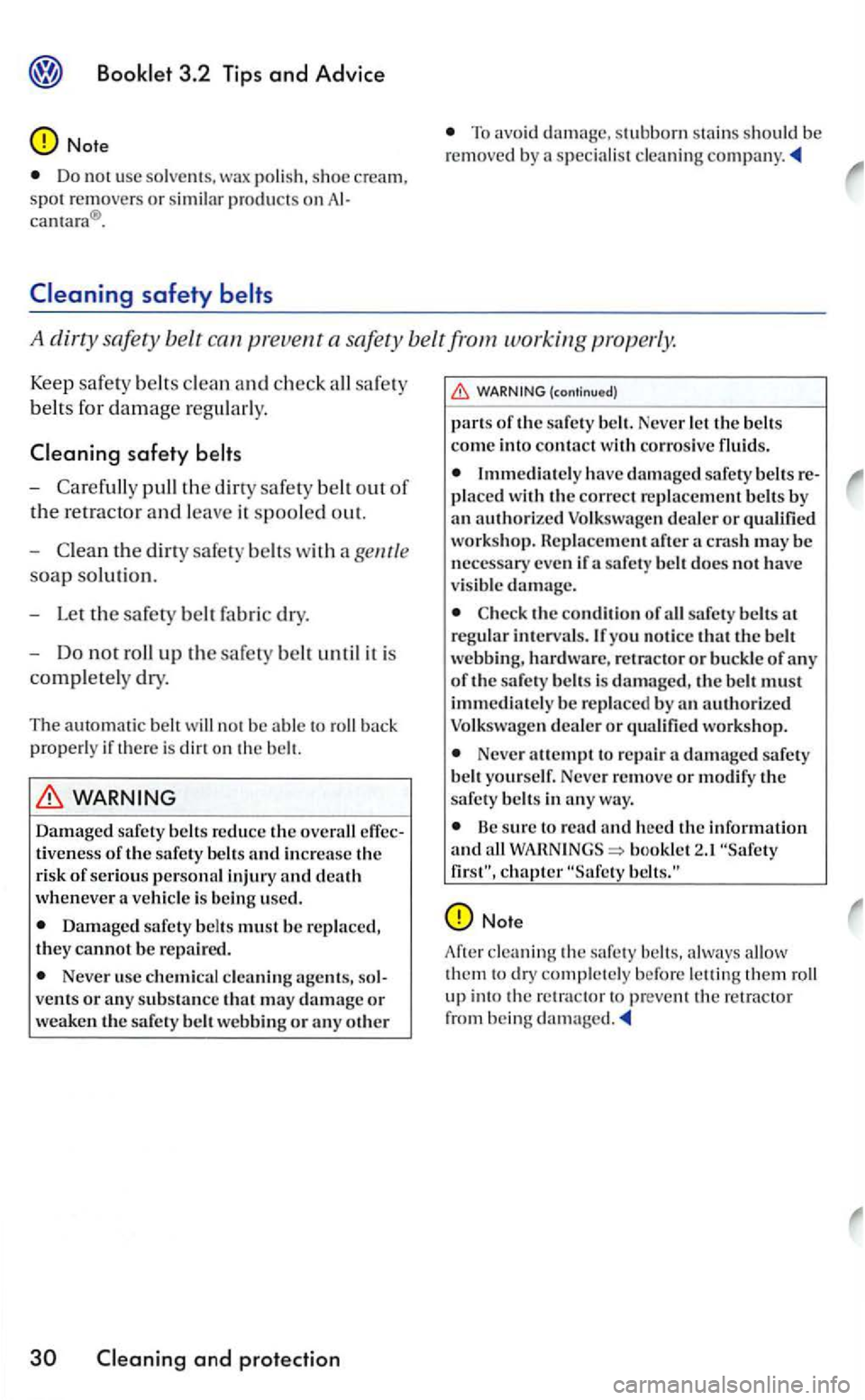
3.2 Tips and Advice
Note
Do not use solvent s, wax polish, shoe cream,
spot removers or similar product s on
To avoid damage,
A dirty safety belt
safety
-pull the
-the safety belts w ith a
Damaged safety belts reduce th e overall tivenes s of the safety belts and increase th e
risk of serious personal inju ry and death whenever a ve hicle is bein g used.
Damaged safe ty belts must be replac ed, they cannot be repaired.
Never use c hemi cal cleaning vents or any substance that may damage or weaken the safety belt webbin g or any othe r
and protection
h ave damaged safety belts
safety belt does not have
visib le
th e condition of all safety belts at
regular interval s. If yo u notice that the belt
webbing , hardware, retractor or buckle of a n y of the safety belt s is th e belt must immediately be rep laced by an authorized dealer or qualified workshop.
Neve r a ttempt to repair safety belt you rself. Never remove or modify th e
safety belts in any way.
Be sure to read heed the information and all 2.1
allow
th em to dry completely before le ttin g them roll up in to the retra ctor to preve nt the retractor
from being
Page 385 of 444
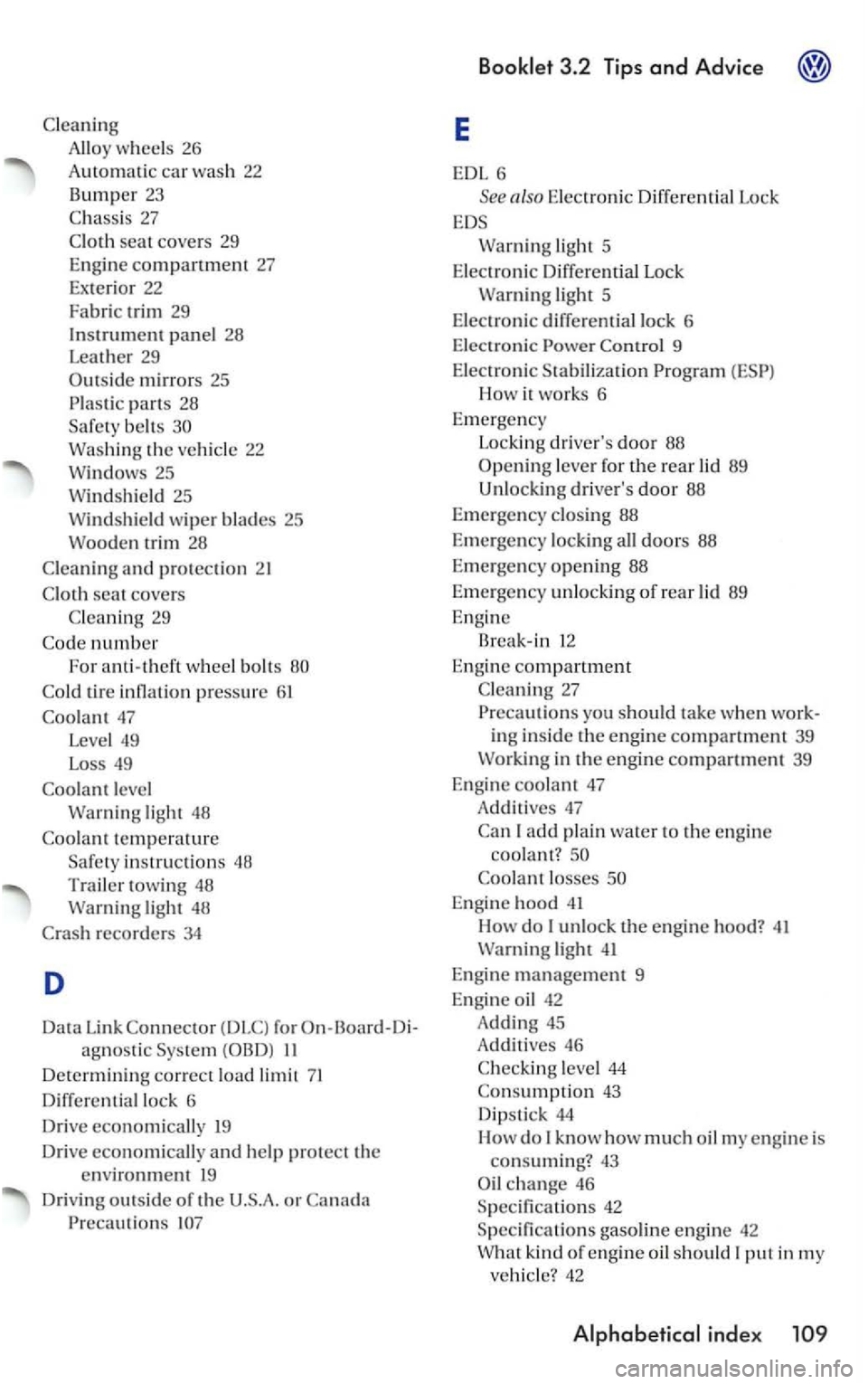
Allo y w heels 26
Auto m
atic car w as h 22
Bumper 23
27
seat cove rs 29
Engine
compartment 27 Exterior 22
Fabric
trim 29
Instrument panel 28
Leat her 29
Outside mirrors 25 part s 28
belt s th e ve hicl e 22
25
tri m 28
and protection 2 1
scat covers
29
numbe r
For anti -
theft wheel bolt s
pressure 6 1
47
L eve l 49
L
oss 49
light 48
temperature
in structions 48
Tr
ailer t o w in g 48 light 48
recorders 34
D
Da ta Link for agnosti c II
D etermin in g correct load limit 71
D ifferentia l lock 6
D rive
econom ically 19
D rive
economi cally and he lp protec t th e environment 19
D
riving o u ts id e of the or Precautions
3 .2 Tips and Advice
light 5
Elec tron ic di
fferential lock 6
Electroni c
Control 9
Electronic
Stabili zat ion
How it work s 6
Em erge ncy
Lockin g drive r's door 88
Opening leve r for the rear lid 89
Unlo ckin g
driver's door 88
Emergen cy clos ing 88
E m erg
ency locking doors 88
E m erge ncy op
ening 88
E m erge ncy
unlocking of rear lid 89
E ngin e
Break-in 12
E ngine
compartment
27
Pr eca utions yo u s ho ul d tak e when working inside th e engine compartment 39
I add pl ain water to the engin e
c o ol
ant?
losses
light 4 1
E n gin e m a
nagem ent 9
E n gin e oil 42
Adding 45 Additi ves 46
leve l 44 43
Dip stick 44
How do I k now how much oil my engine is consuming? 43
c h an ge 46
Specificati on s 42
S pecificat i
ons gasolin e engine 42 kind of engine oil should put in my
ve hicle? 42